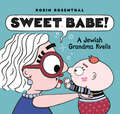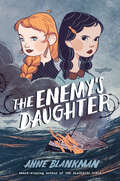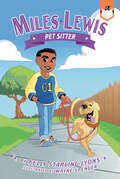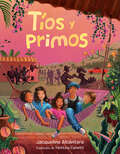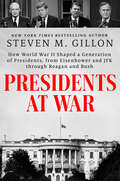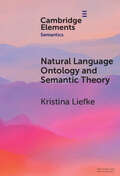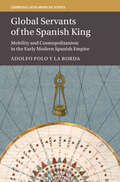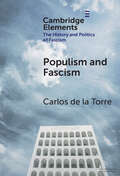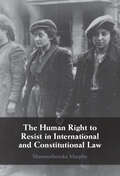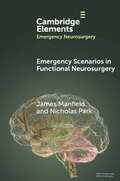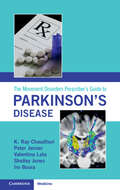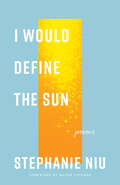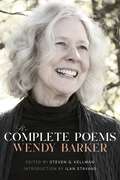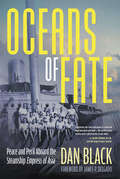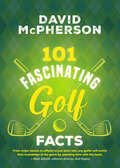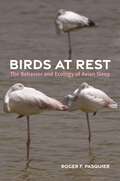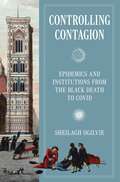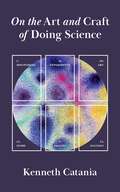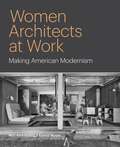- Table View
- List View
Goat Is the G.O.A.T.
by Bea BirdsongA funny misunderstanding sparks a sweet little goat&’s joyful journey to self-discovery.&“He&’s the G.O.A.T. Greatest Of All Time!&”Wow . . . Goat had no idea!But why is he the greatest? Is he the fastest? Nope, Horse easily beats him in a race. Maybe he&’s the strongest? No, that&’s Donkey. Goat isn&’t the highest jumper, either, or even the best spitter—and he&’s definitely not the bravest. Out of ideas of what makes him great, he&’s beginning to doubt that he&’s great at anything when a sudden call for help gives him his chance to shine.Kids will get a kick out of Goat&’s antics and cheer him on as he finally stops comparing himself to everyone else and discovers that there&’s greatness in us all.
Sweet Babe!: A Jewish Grandma Kvells
by Robin RosenthalAn exuberant and interactive picture book for grandparents and their genius, sweet, precious, SO-CUTE-I-CAN'T-STAND-IT! grandbabies, and a celebration of Yiddish and Jewish joy. For fans of Goodnight Bubbala and Leslie Patricelli.Look at this baby . . . what a genius! And such a shayne punim, too! From the top of baby's adorable head to the tips of their toes, there's nothing for a grandma not to adore in her little bubbeleh. Sweet Babe takes babies and their bubbies, not to mention grandparents of every stripe, on a delightful read-aloud journey that practically cries out for frequent cheek-squishing and keppie (head)-kissing in this irresistible celebration of the connection between grandparent and grandchild, and of Jewish joy through the generations.Includes a Yiddish glossary at the back with transliterated vocabulary.
The Enemy's Daughter
by Anne BlankmanIn the spirit of Lauren Wolk and Ruta Sepetys comes the tale of a girl fighting her way back home after surviving the sinking of the Lusitania—and learning to think for herself rather than accept the prejudice of wartime.The year is 1915 and the world is at war. Marta and her father are passengers on the Lusitania, desperately trying to get back home to Germany. While aboard, they must keep their identities hidden or risk being mistaken for enemy spies. Then the Lusitania is attacked by a German submarine. They just make it off the sinking ship, but her father is discovered and detained. Marta suddenly finds herself alone in enemy land.To survive, Marta must draw upon a deep well of bravery she never knew she had. Fortunately, she meets Clare, a young Irish girl who can talk a mile a minute, and her kind family. Believing that Marta is a Dutch refugee, they welcome her into their home. She can't risk letting her new friends know she's actually from Germany—the very nation that the Irish and English are fighting against. But could these people who have shown her nothing but kindness truly be her enemy? Sweeping from the Irish Sea to a cathedral city in England, this story shows us that friendship, especially in times of war, may be the greatest gift of all.
The Garden
by Nick NewmanA darkly beautiful, eerie, hypnotic novel about two elderly sisters living alone at the edge of the world.In a place and time unknown, two elderly sisters live in a walled garden, secluded from the outside world. Evelyn and Lily have only ever known each other. What was before the garden, they have forgotten; what lies beyond it, they do not know. Each day is spent in languid service to their home: tending the bees, planting the crops, and dutifully following the instructions of the almanac written by their mother.When a nameless boy is found hiding in the boarded house at the center of their isolated grounds, their once-solitary lives are irrevocably disrupted. Who is he? Where did he come from? And most importantly, what does he want?As suspicions gather and allegiances falter, Evelyn and Lily are forced to confront the dark truths about themselves, the garden, and the world as they&’ve known it.
Pet Sitter #5 (Miles Lewis)
by Kelly Starling LyonsFrom the award-winning author of the Jada Jones chapter books comes an illustrated spin-off series perfect for STEM fans!When Miles and his classmates welcome a few frogs as class pets, it's a reminder that what he really wants more than anything is a dog to call his own. But his parents don't think he's ready, and his attempts to show them that he truly can care for critters all end in disaster. Can Miles pull it together and prove that he's responsible enough for a pet once and for all?
Tíos y primos (Tíos and Primos Spanish Edition)
by Jacqueline AlcántaraEDICIÓN EN ESPAÑOLUna niña conoce a más parientes de los que puede contar, pero ¿cómo se comunicará con ellos si no puede hablar español con la misma fluidez?A little girl meets more relatives than she can count—but how will she communicate with them if she can&’t speak their language?(edición en español)Es el primer viaje de una niña al país natal de su papá, y ella está impresionada con los paisajes maravillos, los sonidos sorprendentes ¡y especialmente con el tamaño de su enorme familia! Pero sabe solo un poco de español y le resulta difícil compartir chistes y anécdotas con fluidez. Por suerte, sus parientes la ayudan a ver que hay otras maneras de relacionarse. Pronto la niña siente que está justo donde pertenece: en el corazón de una familia amorosa, aprendiendo mientras crece.(Spanish edition)It&’s a little girl&’s first trip to her papa&’s homeland, and she&’s wowed by all the amazing sights and sounds—and especially by the size of her enormous family! But she only knows a little Spanish, and it&’s hard not to be able to share jokes and stories. Fortunately, her relatives help her see that there are other ways they can connect, and soon she feels like she&’s right where she belongs: in the heart of a loving family, learning as she goes along.
Presidents at War: How World War II Shaped a Generation of Presidents, from Eisenhower and JFK through Reagan and Bush
by Steven M. GillonSteven M. Gillon, historian and New York Times bestselling author, is back with the story of how WWII shaped the characters and politics of seven American presidents.World War II loomed over the latter half of the twentieth century, transforming every level of American society and international relationships and searing itself onto the psyche of an entire generation, including that of seven American presidents: Dwight D. Eisenhower, John F. Kennedy, Lyndon B. Johnson, Richard Nixon, Gerald Ford, Ronald Reagan, and George H. W. Bush. The lessons of World War II, more than party affiliation or ideology, defined the presidencies of these seven men. They returned home determined to confront any force that threatened to undermine the war&’s hard-won ideals, each with their own unique understanding of patriotism, sacrifice, and America&’s role in global politics.In Presidents at War, Gillon examines what these men took away from the war and how they then applied it to Cold War policies that proceeded to change America, and the world, forever. A nuanced and deeply researched exploration of the lives, philosophies, and legacies of seven remarkable men, Presidents at War deftly argues that the lessons learned by these postwar presidents continue to shape the landscape upon which current and future presidents stand today.
Natural Language Ontology and Semantic Theory (Elements in Semantics)
by Kristina LiefkeThis Element gives an introduction to the emerging discipline of natural language ontology. Natural language ontology is an area at the interface of semantics, metaphysics, and philosophy of language that is concerned with which kinds of objects are assumed by our best semantic theories. The Element reviews different strategies for identifying a language's ontological commitments. It observes that, while languages share a large number of their ontological commitments (such as to individuals, properties, events, and kinds), they differ in other commitments (for example, to degrees). The Element closes by relating different language and theory-specific ontologies, and by pointing out the merits and challenges of identifying inter-category relations within a single ontology.
Global Servants of the Spanish King: Mobility and Cosmopolitanism in the Early Modern Spanish Empire (Cambridge Latin American Studies)
by Adolfo Polo y La BordaFrom 1580 to 1700, low-ranking Spanish imperial officials ceaselessly moved across the Spanish empire, and in the process forged a single coherent political unit out of multiple heterogeneous territories, creating the earliest global empire. Global Servants of the Spanish King follows officials as they itinerated between the Americas, Asia, Europe, and Africa, revealing how their myriad experiences of service to the king across a variety of locales impacted the governance of the empire, and was an essential mechanism of imperial stability and integration. Departing from traditional studies which focus on high-ranking officials and are bounded by the nation-state, Adolfo Polo y La Borda centers on officials with local political and administrative duties such as governors and magistrates, who interacted daily with the crown's subjects across the whole empire, and in the process uncovers a version of cosmopolitanism concealed in conventional narratives.
Populism and Fascism (Elements in the History and Politics of Fascism)
by Carlos de la TorreThe elections of Donald Trump and Jair Bolsonaro, as well as the strengthening of the radical right globally, brought back debates of the similarities and differences between populism and fascism. This volume argues that fascism and populism are similar in so far that they constructed the people as one; understood leadership as embodiment; and performed politics of the extraordinary. They are different because there is a consensus that fascism occurred at a particular historical moment, and what came after was postfascism. There is not such an agreement to restrict populism to a historical moment. These isms also differ in the use of violence to deal with enemies, and on how they constructed their legitimacy using elections or abolishing democracy. Whereas fascism destroyed democracy and replaced elections with plebiscitary acclamation, populists promise to give power back to the people. Yet when in power the logic of populism leads to democratic erosion.
The Human Right to Resist in International and Constitutional Law
by Shannonbrooke MurphyThe human right to resist is a contemporary legal concept with an ancient pedigree. Although it has received recognition in constitutions, customary international law and human rights treaties, and acknowledgment by leading publicists of international law, it remains obscure compared to other human rights. In this innovative and comprehensive book, Shannonbrooke Murphy addresses the perennial question of who has a 'right' to resist – and what, when, why, and how, from a legal perspective. Using a systematic and comparative approach to analyzing both the theoretical concept and the provisions in positive law, this study aims to establish that a 'right to resist' can be recognized and codified as an enforceable 'human right', proposing a common conceptual language and an analytical framework for evaluating the legal basis of claims. Murphy makes a strong and detailed case for a firmer place for the 'right to resist' in the human rights lexicon.
Emergency Scenarios in Functional Neurosurgery (Elements in Emergency Neurosurgery)
by James Manfield Nicolas ParkFunctional Neurosurgery modifies CNS circuits to effect change within or outside the nervous system. Most commonly, Functional procedures are performed to treat movement disorders, chronic pain, spasticity and epilepsy. Whilst regarded as a predominantly elective subspecialty, emergent scenarios are encountered. The combination of their relative rarity couple with the niche nature of the subspecialty may engender anxiety amongst neurosurgery trainees. This Element overviews some more common emergency scenarios which may be encountered comprising suspected malfunction of intra-thecal drug delivery devices, deep brain and spinal cord stimulators. Status Trigeminus and an approach to investigations with a neuromodulation device in situ are also covered.
Protestant Bodies: Gesture in the English Reformation (Cambridge Studies in Early Modern British History)
by Arnold HuntReligious worship is an embodied act, consisting not of words alone, but of words and gestures. But what did early modern English Protestants think they were doing when they went through the motions of worship? In Protestant Bodies, Arnold Hunt argues that the English Reformation was a gestural reformation that redefined the postures and motions of the body. Drawing on a rich array of primary sources, he shows how gestures inherited from the medieval liturgy took on new meanings within a drastically altered ritual landscape, and became central to the enforcement of religious uniformity in the sixteenth and seventeenth centuries. Protestant Bodies presents a challenging new interpretation of the English Reformation as a series of experiments in shaping and remaking the body, both individual and collective, with consequences that still persist today.
The Movement Disorders Prescriber's Guide to Parkinson's Disease
by K. Ray Chaudhuri Peter Jenner Valentina Leta Shelley Jones Iro BouraThis concise, yet authoritative, clinical reference guide fulfils the needs of diverse clinicians, pharmacists and allied health professionals prescribing for Parkinson's disease and movement disorders in contemporary clinical practice. With chapters on newly approved drugs and their effects on motor and non-motor symptoms, information is also given on their use in particular populations including the elderly and patients with cognitive impairment. Each chapter includes pharmacological/biochemical rationale for drug use, a general guide to therapeutic use, pharmacokinetics, interaction profile, adverse effects, dosing and use, special population considerations, costs and value for money considerations, clinical vignette, a summary overview, and suggested reading. Ordered alphabetically and perfect for quick reference use, the guide is practical and essential for all prescribers with responsibility for patients with Parkinson's disease, including neurologists, geriatricians, internists, neurosurgeons, psychiatrists, family physicians, pharmacists as well as allied health professionals and resident, fellow, and student trainees in all related medical fields.
Pursuing Institutional Purpose: Profiles of Excellence (Cambridge Education Research)
by Alan Ruby Matthew HartleyWe are living in an era where global university schemes only offer narrow conceptions of quality, relying too heavily on international ranking systems. This timely book present an alternative perspective on evaluating 'world-class universities', showcasing how eight very different higher education institutions have defined and are pursuing excellence in their own way. Each case study highlights how institutions can align their work with shared values and goals, and strive to uphold these principles in all they do and say. The portraits offer insights into the ways institutions can create cultures of excellence tied to a vision of how to make a difference for their students and society. Their success suggest that policy makers should reward institutions that adopt and strive to fulfil particular educational purposes rather than continuing to perpetuate the status quo. It is essential reading for researchers and students of education research, education policy, and international education reform.
I Would Define the Sun: Poems (Vanderbilt University Literary Prize)
by Stephanie NiuStephanie Niu&’s I Would Define the Sun, awarded the 2024 Vanderbilt University Literary Prize, is a collection of poems that declare the impossibility of defining something as immense as the sun while striving toward that impossible act. In an era of planetary collapse, filled with bushfires, bleached coral, and burnout, Niu explores what love can do even through estrangement, even through being together at the end of the world. Recycling and folding language through duplexes, sestinas, and echoing couplets, this collection moves across great distances to include Christmas Island, Chinese-American immigration, and the precarity and abundance of the sea through formal and lyric poetry. Expansive in scope, Niu refits the world into a size &“made for [her] hands, [her] human tongue,&” propelling readers into continuous motion as she searches for home.
The Complete Poems
by Wendy BarkerSpanning more than three decades of a life well-lived, Wendy Barker’s collected poems convey her encounters with the natural world, her reactions to contemporary social problems, and her experiences in high school and college classrooms. Adored by her students, many of whom became published poets themselves, Barker crafted verse that often recreated her presence in the classroom and her engagement with questions of identity, ethics, and the value of literature. Organized chronologically, this volume enables readers to marvel at the growth of a singular sensibility attentive to the wonders of love and the anguish of mortality. Edited by her husband, Steven G. Kellman, and featuring an introduction by acclaimed scholar and translator Ilan Stavans, Wendy Barker’s Complete Poems presents the life’s work of a steadily productive, brilliant poet and beloved teacher.
Building Mennonite Belonging: Toward an Intercultural Church
by Hyung Jin Kim SunHyung Jin Kim Sun is a Mennonite. He was born in Paraguay and raised by a Korean immigrant family, before attending an evangelical seminary in the United States. There he joined a Mennonite church, though he often returned from gatherings feeling uneasy. Most Mennonites he met were white, with European heritage, and their faith community was often their ethnic community as well. As a Korean-Paraguayan, Kim Sun felt that he would never be Mennonite enough. This crisis of religious identity prompted him to work towards an intercultural Mennonite church where all people could experience full belonging.Building Mennonite Belonging explores the interplay between ethnicity, culture, race, and faith in Canada and other multicultural societies. Using three Mennonite theologies – messianic community, missional church, and shalom church – Kim Sun navigates the intersection of identity and belief to broaden the vision of Mennonite peoplehood. These theologies show that Mennonites aspire to engage with the world, dialogue with those from diverse backgrounds, seek peace, and strive for reconciliation. The materials to build an intercultural church can be found within existing Mennonite teachings and traditions. Though centred on Mennonites, Kim Sun’s insights resonate with any faith community grappling with ethnocultural and racial diversity.Envisioning new possibilities for faith communities in the twenty-first century, Building Mennonite Belonging advocates for a church that reflects and responds to the diverse society it inhabits. Kim Sun’s work is not only a call to action, but a guide to fostering a more inclusive church and society.
Oceans of Fate: Peace and Peril Aboard the Steamship Empress of Asia
by Dan BlackThe remarkable story of how one ship — doomed by war — intersected lives and crossed into history. Completed in 1913 for Canadian Pacific, the Empress of Asia plied the oceans for nearly 30 years. Built for long-haul ocean travel during peace-time, she saw wartime service as an armed merchant cruiser and troopship before Japanese dive-bombers destroyed her in 1942. Through the Roaring Twenties and the Great Depression, she brought continents and people together, delivering mail and multimillion-dollar consignments of silk. As a luxurious passenger liner, she was a “Greyhound of the Pacific,” braving epic storms and smashing transpacific speed records. From stokehold to bridge, steerage to first-class staterooms, she steamed with a kaleidoscope of lives, including courageous and recalcitrant crew, immigrants and refugees seeking a better life or relief from disaster, drug smugglers, weapons dealers, and the idle and not-so-idle rich. This is the dramatic story of how that one ship and the lives of those on board intersected during a tumultuous period of world history, culminating in her sinking off Singapore in the Second World War.
101 Fascinating Golf Facts (101 Fascinating Facts)
by David McPhersonTee off your season with 101 delightful trivia on the greatest game.Did you know a Canadian coined the term “mulligan” — a noun meaning “do-over” — which many recreational golfers take on the first tee after an errant drive? Or that the creators of one of the greatest board games ever, Trivial Pursuit, also built a devilish golf course north of Toronto? How about this fact: the world’s most expensive public golf course will set you back $1,000 to play just one round. Here’s one more: Scotland, where golf was invented in the Middle Ages, later banned the sport — not just once, but three times.In 101 Fascinating Golf Facts, author, historian, and award-winning golf journalist David McPherson shares these stories and 97 more fascinating and fun tales that illustrate the sport’s rich history, entertaining both golf lovers and trivia buffs alike.
Guilt and Finnegans Wake: From Original Sin to the Irredeemable Body (The Florida James Joyce Series)
by Talia AbuExploring the important themes of guilt and morality in James Joyce’s final work James Joyce’s last novel, Finnegans Wake, is notorious for its complex structure and is considered by many to be unreadable. Approaching this complicated book with attention to the theme of guilt, an important concept that has been underexplored in studies of the Wake, Talia Abu presents a clear and thorough interpretation that helps illuminate the book for even the most novice Joyce readers. In Guilt and “Finnegans Wake,” Talia Abu examines how Joyce portrays the evolution of cultural beliefs about morality, from the concept of a moral code set in place by a transcendental authority to an embodied morality that originates in material existence. Through close readings of the novel, Abu demonstrates that Joyce engages with guilt as it relates to the Catholic doctrine of original sin, the institution of the marriage contract, the theories of Nietzsche, and the views of Freud—including Freud’s emphasis on physical experience as the primary aspect of being. Ultimately, Abu argues that Joyce sees guilt as a personal and unique experience and that emotions such as guilt can be reclaimed from the influence of religious and social institutions. Delving into Joyce’s representation of historical events while also analyzing Joyce’s wordplay and linguistic techniques and drawing from multiple disciplines to understand different conceptions of guilt, this book shows the importance of the theme to the form of Finnegans Wake and Joyce’s craft more broadly. Pursuing the questions and ideas that Joyce raises about guilt and morality, Talia Abu makes a case for the enduring relevance of Joyce’s work today. A volume in the Florida James Joyce Series, edited by Sam Slote
Birds at Rest: The Behavior and Ecology of Avian Sleep
by Roger PasquierA wide-ranging account of how birds spend the quiet half of their livesBirds at Rest is the first book to give a full picture of how birds rest, roost, and sleep, a vital part of their lives. It features new science that can measure what is happening in a bird&’s brain over the course of a night or when it has flown to another hemisphere, as well as still-valuable observations by legendary naturalists such as John James Audubon, Alfred Russel Wallace, and Theodore Roosevelt. Much of what they saw and what ornithologists are studying today can be observed and enjoyed by any birder.From the poles to the tropics, how, when, and where birds sleep reflect the ecology and behavior of each species, as well as their evolution from dinosaur ancestors. Some sleep briefly, their brain half awake, others spend long cold nights in torpor, and a few can sleep while flying. Their roosting habits are also varied. Most birds sleep alone, some in pairs or families, while others in flocks of millions. Birds at Rest explains how each strategy works over the course of a season, a year, or a lifetime by providing protection, mating opportunities, information about food, and other survival benefits.With evocative drawings by artist and illustrator Margaret La Farge, Birds at Rest discusses how environmental challenges such as artificial lights and noise, invasive species, and climate change are disrupting avian sleep and proposes solutions to ensure that birds get the rest they need.
Controlling Contagion: Epidemics and Institutions from the Black Death to Covid (The Princeton Economic History of the Western World)
by Sheilagh OgilvieHow human institutions—markets, states, communities, religions, guilds and families—have helped both to control and to exacerbate epidemics throughout history.How do societies tackle epidemic disease? In Controlling Contagion, Sheilagh Ogilvie answers this question by exploring seven centuries of pandemics, from the Black Death to Covid-19. For most of history, infectious diseases have killed many more people than famine or war, and in 2019 they still caused one death in four. Today, we deal with epidemics more successfully than our ancestors managed plague, smallpox, cholera or influenza. But we use many of the same approaches. Long before scientific medicine, human societies coordinated and innovated in response to biological shocks—sometimes well, sometimes badly.Ogilvie uses historical epidemics to analyse how human societies deal with &“externalities&”—situations where my action creates costs or benefits for others beyond those that I myself incur. Social institutions—markets, states, communities, religions, guilds, and families—help us manage the negative externalities of contagion and the positive externalities of social distancing, sanitation, and immunization. Ogilvie shows how each institution enables us to coordinate, innovate and inspire each other to limit contagion. But each institution also has weaknesses that can make things worse. Markets shut down voluntarily during every epidemic in history—but they also brought people together, spreading contagion. States mandated quarantines, sanitation, and immunization—but they also waged war and censored information, exacerbating epidemics. Religions admonished us to avoid infecting our neighbours—but they also preached against science and medical innovations. What decided the outcome, Ogilvie argues, was a temperate state, an adaptable market, and a strong civil society where a diversity of institutions played to their own strengths and checked each other&’s flaws.
On the Art and Craft of Doing Science
by Kenneth CataniaA scientist&’s personal reflections on how to harness creativity and curiosity to generate new ideas and discover the unexpectedLike any creative endeavor, science can be a messy and chaotic affair. On the Art and Craft of Doing Science shares the creative process of an innovative and accomplished scientist, taking readers behind the scenes of some of his most pioneering investigations and explaining why the practice of science, far from being an orderly exercise in pure logic, is a form of creative expression like any other art.Kenneth Catania begins by discussing how ideas set the stage for scientific breakthroughs and goes on to describe ways to approach experimental design. He sheds light on the importance of art in making discoveries and demonstrates how to find and tell a compelling story about a scientific result while accurately communicating its findings. What role does failure play in science? Is it possible to fail better? How do you define success? Catania provides insights to these and other questions, along the way sharing the lessons he&’s learned from diverse figures ranging from science philosopher Thomas Kuhn to novelist Stephen King.Blending illuminating historical examples with insights from Catania&’s own groundbreaking research in biology and neuroscience, On the Art and Craft of Doing Science draws parallels with art and writing to reveal the creative side to the practice of good science.
Women Architects at Work: Making American Modernism
by Mary Anne Hunting Kevin D. MurphyA comprehensive history of the women architects who left their enduring mark on American ModernismIn the decades preceding World War II, professional architecture schools enrolled increasing numbers of women, but career success did not come easily. Women Architects at Work tells the stories of the resilient and resourceful women who surmounted barriers of sexism, racism, and classism to take on crucial roles in the establishment and growth of Modernism across the United States.Mary Anne Hunting and Kevin D. Murphy describe how the Cambridge School of Architecture and Landscape Architecture in Massachusetts evolved for the professional education of women between 1916 and 1942. While alumnae such as Eleanor Agnes Raymond, Victorine du Pont Homsey, and Sarah Pillsbury Harkness achieved some notoriety, others like Elizabeth-Ann Campbell Knapp and Louisa Vaughan Conrad have been largely absent from histories of Modernism. Hunting and Murphy describe how these innovative practitioners capitalized on social, educational, and professional ties to achieve success and used architecture to address social concerns, including how modernist ideas could engage with community and the environment. Some joined women-led architectural firms while others partnered with men or contributed to Modernism as retailers of household furnishings, writers and educators, photographers and designers, or fine artists.With stunning illustrations, Women Architects at Work offers new histories of recognized figures while recovering the stories of previously unsung women, all of whom contributed to the modernization of American architecture and design.

